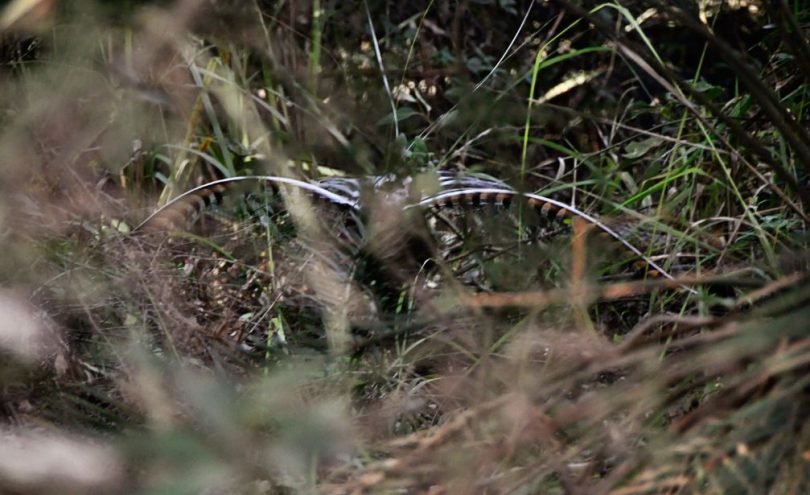
The male holds his tail over his head like an umbrella as part of his dance. Photo: Jesse Rowan.
Residents living on the edge of forests around Malua Bay are lucky to hear lyrebirds singing their hearts out. A recent close encounter prompted me to find out more about my feathered neighbours.
Armed with my smartphone, I have spent many hours creeping in the forest near home to track down this elusive singer. I found several lyrebird mounds surprisingly close to houses. My patience and stealth were rewarded when I witnessed a mating song performed on a mound up close and was awestruck with its beauty and volume.
Lyrebirds can be heard at dawn and dusk throughout the year, but they sing with most intensity through the peak of the breeding season, from June to August, for about four hours a day.
Superb Lyrebirds are famous for their extraordinary ability to mimic both natural and artificial sounds heard in their immediate surroundings such as chainsaws, car engines, car alarms, nail guns, hammering, dog barks, flapping wings as well as a variety of local native birds.
Their song is extremely loud for the size of the bird and their impersonations are so accurate that they can even fool the bird they’re mimicking.
In between imitated sounds is a chorus of the lyrebird’s own unique whistles and complex trilling that are used as territorial calls.
From about the age of three years, the male Superb Lyrebird has an amazingly beautiful tail. When spread out in display it is shaped like a lyre – a musical instrument of ancient Greece.
The male builds several mounds of scratched earth within his territory which he uses like a concert stage. He sings while throwing his tail forward over his body and shaking it. Females are attracted to the mound by the male’s elaborate tail display and song.
Males will mate with several females, but leave the hard work to the females, who are left to build the nest and feed the young. Females also sing and imitate as they forage for food.

A lyrebird stage waiting for its star. Photo: Jesse Rowan
The female builds a dome-shaped nest of sticks lined with ferns, her own feathers and moss. Nests are constructed on the ground, among rocks, or in tree stumps. She lays one egg, which hatches in around 50 days. The young lyrebird is born helpless, without feathers, and relies on its mother for about ten weeks.
A lyrebird’s home range is about 10 km in diameter and they can live for up to 30 years. They scratch in leaf litter for insects, worms and frogs. The Superb Lyrebird can be found in areas of moist forest in Victoria, New South Wales, and south-east Queensland. It is also found in Tasmania where it was introduced in the 19th century.
Young lyrebirds take about a year to perfect their song, learning from other lyrebirds as well as from direct sources. Tasmanian lyrebirds still have bird calls in their repertoire which are not native to Tasmania, proving that their calls get handed on to their young and to other lyrebirds.
There is a great story which has been verified by various experts, that a flute player living near Dorrigo in NSW in the 1930’s taught his pet lyrebird to whistle ‘The Keel Row’, a simple Scottish tune. When released back into the wild, this lyrebird then influenced others in the area, and over 70 years later lyrebirds over 100 km away were recorded singing snippets of the same tune.
Lyrebirds are shy, and not easily seen. Their brown feathers blend into the leaf litter and their exceptional hearing protects them well.
The oldest songbirds in the world, the Australian Museum holds fossils of lyrebirds dating back to about 15 million years ago – human evolution dates from about 6 million years ago.
I feel very blessed to share my backyard with these beautiful ancient performers.
Sources used – Britannica, Wikipedia, Australian Museum, ABC Science, Environment NSW, Awesome Stories.







